Landskrona
Landskrona (old Danish: Landskrone) is a late medieval town in Scania province of Sweden, located at the shores of Øresund, founded at the location of the former Danish fishing village Sønder Sæby in the province of Scania by king Erik VII of Pomerania[2] early in the 15th century.[3] In 1720 the town, like its province, became a formal part of Sweden.,[4][5] contrasted with the 1658–1676, 1679-1711 and 1711-1720 periods. As land owned by the Swedish Monarch. Scania's status, thus the town's as well, was during those periods equal to the one of Swedish Pomerania. During the Danish 1676-1679 reconquest of large parts of her in 1658 lost territories, Landskrona Citadel constituted as mobilisation centre for formal enlistment of pro-Danish guerrilla fighters from 1678.[6]
Landskrona | |
|---|---|
The old water tower in Landskrona is a landmark that can be seen from far away | |
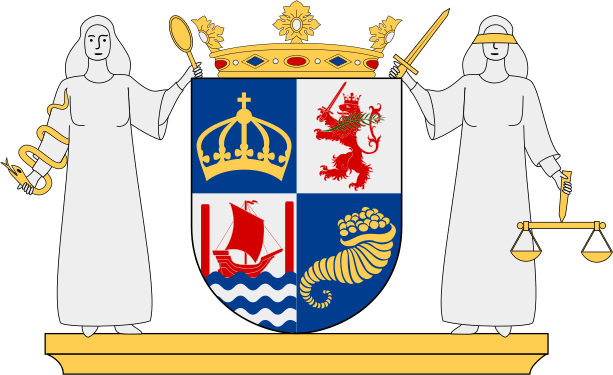 Coat of arms | |
 Landskrona  Landskrona  Landskrona | |
| Coordinates: 55°52′N 12°50′E | |
| Country | Sweden |
| Province | Scania |
| County | Scania |
| Municipality | Landskrona Municipality |
| Charter | 15th century |
| Area | |
| • Total | 12.09 km2 (4.67 sq mi) |
| Population (31 December 2010)[1] | |
| • Total | 30,499 |
| • Density | 2,524/km2 (6,540/sq mi) |
| Time zone | UTC+1 (CET) |
| • Summer (DST) | UTC+2 (CEST) |
Around the Castle build by Danish king Christian III in 1549, Landskrona Citadel,[7] a huge system of moats emerged over the centuries, also in the town's Swedish history. Today the Citadel is famous for its well-preserved moat system, which includes parts of four moats. At the northern part of the Citadel, Sweden's second, and today oldest allotment area is located. Its port is based on a natural chute in the sandy sea floor,[8] despite the lack of any nearby debouching river.
The town is the seat of Landskrona Municipality. The town, which in March 2013 celebrated its 600th birthday, had close to 33,000 inhabitants at that time.[9]
For many years the town had a car ferry line to Copenhagen (Tuborg harbour, 70 minutes).[10][11][12] Landskrona is located close to the Danish capital. From Rådhustorget (Town Hall Square) in Landskrona to Amalienborg Royal Palace in central Copenhagen, the crow flight distance is around 22–23 km. In the later parts of the 19th century, the town was transformed from a military settlement to a heavy industrial town. Between 1917 and 1983, the Öresundsvarvet shipyard had up to 3,500 employees,[13] but the town also had large manufacturers in the chemical and textile industry sectors. The football club Landskrona BoIS, which has participated in both of the top two Swedish league divisions during all but seven seasons (as of November 2017), ever since the Swedish football league system began in 1924–25, has always been important for the town and its inhabitants.
History
The city of Landskrona is usually claimed to have been founded in 1413 by the King of Denmark, Eric of Pomerania, as a trading city intended to compete with Danish towns under the control of the Hanseatic League. There is however evidence found in the Danish National Archive, which mention the town by the name "Landzcrone" already in 1405.
The site possesses the best natural harbour in Scania, which at that time was part of Denmark. At the time of foundation, the site held a fishing settlement named Sønder Sæby.[note 1] The original name of the officially founded town was Landszcrone, which changed to Landskrone sometime before 1450.[14]
A Carmelite monastery was founded in 1410, English merchants were granted the privileges in a royal charter in 1412, and the town itself was chartered in 1413. The monastery was closed by King Christian III after the reformation, but survives in the name of the street "Karmelitergatan".[note 2]
The town supported the king Christian II in 1525, and opposed the Reformation in Denmark (1535); in both cases it found itself on the losing side. The reformist king Christian III of Denmark opted not to retaliate against the town, and instead founded a castle to protect the harbour. The castle, built where the monastery had been situated until the Reformation, was completed by 1559.[15]
After Scania was ceded to the Swedish Crown in 1658, the good harbour and strong fort motivated plans to make Landskrona a commercial center of the acquired territory, with extraordinary privileges for foreign trade. The castle was reinforced by bastions, and the area inside the moats extended to 400x400 meters. The castle was considered the strongest and most modern in Scandinavia, but was temporarily lost to the Danes after a comparably short siege lasting from July 8 to August 2, 1676. The commandant, Colonel Hieronymus Lindeberg, was consequently sentenced to death for high treason.[7]
In 1753 the Swedish military commander feared that the tower of Sancti Johannis Baptistae church could be a threat to the citadel and demanded the demolition of the church.[16] Even though the cornerstone of the new Sofia Albertina Church was laid the following year, it was not inaugurated until 1788, and was finally completed in 1812. Unusually for a church that is not a diocesan seat, the new church was built with two towers, possibly in compensation for its much larger medieval predecessor.
Landskrona's military importance declined after the 18th century. The continued Swedish–Danish wars led to Karlskrona replacing Landskrona as a naval base, as it is located at a safer distance from Denmark. Although the fortifications at Landskrona were expanded considerably between 1747 and 1788, they were condemned in 1822, whereafter the garrison was abolished in 1869. The last military regiment, Skånska Husarregimentet, K5 was renamed and moved from Landskrona to Uppsala in 1926.[17][18] Today the walls and moats of the fortifications of Landskrona Citadel are a recreational area and the castle holds a museum. On the northern side, an allotment-garden area of cottages was founded in the final years of the 19th century, and is today the oldest of its kind in Sweden.[19] The military's large exercise field became a public heath, today called "Exercisfältet" or "Exan".[20]
The town grew quickly after the industrial revolution and subsequent urbanization. During the first World War a large shipyard, Öresundsvarvet was constructed. In the mid-1970s the shipyard employed more than 3,500 people, in a town with only 30,000 inhabitants. The shipyard was closed down in stages from the late 1970s, finally closing in 1983.[13]
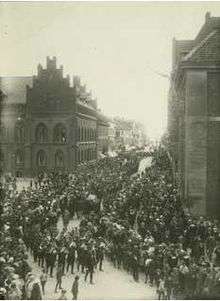

On 14 May 1919 the Swedish engineer and flight pioneer Enoch Thulin, who lived and worked in Landskrona, died when he crashed his own airplane at the Södra Fäladen fields. His funeral service was held in Sofia Albertina Church.[21]
Between 1930 and 1939 the Saxtorp TT-races were held just south of the town. The races attracted up to 160,000 attendees and are considered the largest sporting events by crowd size ever held in Sweden.[22][23]
Townscape
The town's centre and buildings along the entrance streets generally consist of buildings with between two and seven floors. Some of the buildings may give an impression of the town being larger than it actually is. Landskrona was also relatively larger a century ago compared with today. After World War One the town was among the 15 largest in the country. But no longer holds that position.[24] Between approx. 1880 and 1920 was the town transformed from a military town to a town with much heavy industry within many sectors. The Öresundsvarvet shipyard, which opened in 1917, became the largest employer (with close to 4000 employees in the early 1970s). But the industry was not limited to shipbuilding, and a sugar refinery, several textile industries, fertilizers and other chemical plants, as well as a spectrum of various manufacturing industries, grew up. But after the First World War, the town stopped growing as fast as many other Swedish towns did. And the very last military regiment moved to Hässleholm in 1924. Between the mid-1920s and mid-1970s the town grew from approx. 20,000 inhabitants to 30,000. And after the Swedish municipality reforms reached its end point, in 1974, the municipality counted around 38,000 inhabitants.[25]
During "The Demolition Rampage Era", in Sweden a period between 1955 and 1975, when the word "old" in general meant "bad", in the context of architecture. Typically department stores and parking houses replaced older buildings in town and city centres. Landskrona was relatively spared from this, but not entirely. Around "Rådhustorget", the Town Hall Square, all but one building was built before Le Corbusier's Functionalism became popular. Most demolished buildings were low or of minor architectural value, but "Falcks hörna" (a block corner building with a rather unusual look) was considered a loss to the town in 1971. Due to the storm of protests, the building had to be demolished in the middle of the night.[26][27][28] The replacement building in yellow brick stones with a flat roof, included a bank office which at the time was known as Kreditbanken, which after several mergers and name changes (PK Banken, Nordbanken) eventually became Nordea. In 2015 the bank left the town.
As a fortified town, stone houses were early preferred instead of wooden houses. Hence few examples of traditional Danish and Scanian half-timbered houses exists. Apart from the Castle (the actual building at the Citadel) and Sofia Albertina Church, other notable 19th-century or older buildings are "Rådhuset", the Town Hall, Landskrona museum, the old Railway station building and the Theatre.
By 1901 the town employed its first town architect, and much of the town's central parts, and buildings along the (partly former) entrance roads are characterized by the former town architects Fredrik Sundbärg 1901–1913[29] and Frans Ekelund 1913–1949.[30][31] Sundberg created a number of monumental buildings like the old Water tower, the remarkable school "Tuppaskolan", the power station and a hot bathhouse (which though was demolished in the 1970s), as well as two large block of flats Falken and Gripen, mainly intended for the working class.[29]
Ekelund, who was a believer in "Trädgårdsstaden" or Garden City, created areas within for own homes within the town limits.[30] Ralph Erskine created the row house area called "Esperanza" (Spanish for hope) around 1970. In that year also the "UFO-inspired" new Water Tower was taken into operation. No real monumental building has been built since then. Not even the new railway station can be considered as a such building.
Transport

The island of Ven can be reached through a regular ferry connection. The ships used for this transport usually depart 9 times a day. Extended service is also available during July and August.[32]
The town's first railway station opened in 1863 and was located a short walk from Rådhustorget, the City Hall Square.[33] In the 1920s was Landskrona station the western terminal of three railway lines. To Eslöv, Kävlinge (from which some trains continued to Lund and Malmö) and to Billesholm. It's notable that during the 1860 to 1940 construction of the Swedish railway network, there wasn't build a railway to the nearby city of Helsingborg. The line to Billesholm was short-lived and closed before the 1960s. During the mid 1970s was the Swedish National Railways, SJ considering to close all local train service in the south. But along with other towns and cities in the former Malmöhus län, did Landskrona participated in forming a new local railway system, which got the very Scanian name Pågatåg. This new railway system, which opened in a minor scale in 1983, was the first of its kind in Sweden, outside the Stockholm area.[34] In connection with the construction of the Øresund Bridge, another train system was introduced, called the Øresundståg. They are Inter-regional trains as well as international ones, and are partly linking Denmark and Sweden together in the field of railways. For Landskrona this meant that there was a call for a new location of the station, in order to avoid both the terminal station type, as well as open up also for northbound traffic. After political discussions was it also decided to build a new dual track high speed railway between Helsingborg and Lund, as a part of a planned West Coast Railway between Copenhagen and Gothenborg. As Landskrona is located between Helsingborg and Lund, Landskrona became included in the planning for the new railway. But, as the new railway just "touched" the town's eastern end, there was a need for a new station in that area. The new station, located at what until the late 1990s, were agricultural areas, now delineates the clear boundary between town and countryside. The new station, which opened in January 2001, allowed for a greater range of train operations, compared to the old terminal for southbound trains only. Today, all local Pågatågen trains and inter-regional Øresundståg trains stop at the new station, which gives the new station a frequent weekday service of 4-6 trains per hour in each direction.
A trolleybus shuttle service (the "Station Shuttle") was introduced in September 2003[35] links the new station with the city centre and the ferry terminal in the harbour. It is (by 2017) possible to reach Copenhagen Airport in 50 minutes and central Copenhagen in 65 minutes. It's also possible to reach Copenhagen by northbound trains to Helsingborg and then by the HH ferry route make a 20-minute sea travel to Helsingør, and from there take another train to Copenhagen. Although the (initially) northbound way for central Copenhagen includes two changes, is the Danish Capital normally reached in less than 90 minutes.[36]
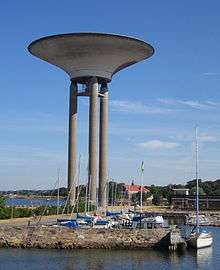
Harbour

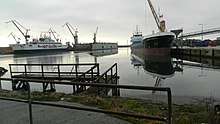
A natural deep harbour has existed here for a longer time than the town has been known. It's mentioned in the Danish historical work Saxo Grammaticus from around 1200[37] Since the 18th Century, the harbour has been protected by the artificial island Gråen. In the 1960s it had a total quay length of around 3 km[38] As of 2017 its usable quay length has been greatly reduced, with a tally of approximately 1250 meters of remaining quay,[39] and its activity has been low for decades. The former car ferries to Copenhagen-Tuborg departed from the Nyhamn port, in the northern end. At a common map, it looks like the harbour has two inlets. But the waters immediately south of the harbor are extremely shallow.[40][41] The northernmost part of Lundåkrabukten, the bay between Landskrona and Barsebäck, is not just shallow, but also largely free of stronger currents. During cold winter periods, Sea ice can then be formed here, much faster than at most other places in Øresund.
History of the Øresund traffic
For many years, Landskrona was serviced by car ferries and other ships to and from Copenhagen. From 1951 to 1980 did the SL ferries operate the route between Port of Tuborg in northern Copenhagen and Landskrona. During a larger part of that period, also the Viking Bådene [42][43][44][45] operated smaller passenger ships between the inner port of Copenhagen harbour. They were owned in Denmark, but from around 1970 they were purchased by the Swedish Centrumlinjen but kept their name. The 1973 energy crisis eventually caused the end of this shipping line.[46]
Between 1980 and 1984 different kind of ships and shipping lines offered at least summer time traffic to Copenhagen. And From 1985 Scarlett Line was formed, and once again sailed to Port of Tuborg. From the spring of 1991 did Danish Vognmandsruten A/S merge with Scarlett Line, maintained the established name and began to sail every hour. The new shipping line mainly was intended to live on transport of lorries. In the autumn of 1993 Vognmandsruten A/S went bankrupt and this put an end to the car and lorry ferry traffic from Landskrona.
However, hydrofoil speedboats Flygbåtarna AB, which previously only had served passenger traffic in the southern part of Øresund, between Malmö and Copenhagen, now began to operate also from both Landskrona as well as from Helsingborg. Not until March 2002, almost two years after the inauguration of the Øresund Bridge did Flygbåtarna AB threw in the towel.[47][48]
Copenhagen Airport influence
Aircraft approaching the nearby Copenhagen Airport to land on Runway 22L pass over the northern part of the town, where they make a sharp right turn towards the south to intercept the localiser around Barsebäck.[49] Most landings at Copenhagen take place at Runway 22L.[50] At the busiest times this can lead to consecutive aircraft passing over Landskrona with less than a minute's gap between them.[51]
Sports
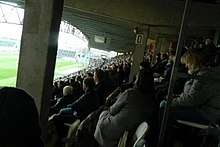
The Landskrona BoIS football club is located in the town and since 1924 has had their home at Landskrona IP. It's by far the most popular local sports club. The club was formed through a merger of two older clubs in 1915. "BoIS" was one of the twelve original football clubs in Sweden's premier football assembly, Allsvenskan 1924/25, and has participated for 34 seasons. Their latest Allsvenskan spell was four seasons long, 2002 to 2005.
The club has four Allsvenskan medals (but no Gold) and they won the Cup in 1972. Landskrona BoIS attendance record is 18,535, and crowds larger than 10,000 once or twice per year, has been common since the 1950s, especially when the club manages to participate in Allsvenskan. As of the 2018 season, Landskrona BoIS will play in Sweden's second tier league, Superettan.
Between 1930 and 1939 the annual Saxtorp TT-races motorcycle events saw enormous crowds of up to 160,000. Saxtorp is located some 10–15 km south-east of the town centre.
Art
Landskrona Konsthall was built in 1963. With its clear architectural language and its window walls it is one of the most exceptional art galleries in Skåne. The gallery is located in the castle park of Landskrona in front of Landskrona Citadell.[52] There are many sculptures by artists like Ulla Viotti, Bertil Herlow Svensson, Claes Hake, Staffan Nihlén, Lena Lervik, Jan Janczak, Bie Norling, Lone Larsen och Pål Svensson.
Pumphuset Konsthall is run by the Borstahusen Art Association, one of the largest non-profit art associations in Sweden. The art gallery has been named one of Sweden's foremost. It has six exhibitions a year with Scandinavia's leading contemporary artists have established Pumphuset Konsthall as an institution in the art world. It also contains a permanent exhibition about the village, as well as one of Sweden's best art galleries, located right at the waterfront.
Carl Fredrik Reuterswärd, was a Swedish painter and sculptor. He lived at the end of his life in Landskrona and died of pneumonia at Landskrona Hospital, on 3 May 2016, aged 81. He was a professor of painting at The Academy of Fine Arts in Stockholm from 1965 until 1969. In 1974, he was a guest professor at Minneapolis School of Art in Minneapolis, Minnesota. In 1986 he was awarded the Prince Eugen Medal for painting. Reuterswärd was known for his sculpture showing a revolver tied in a knot, called Non violence. It is outside of the United Nations Headquarters in New York City.[53]
British Artist Ian Berry who is famed for his artwork made from only denim jeans lived in Landskrona between 2010-2015 and made some of his artwork based on Landskrona and the Oresund Region. In 2013 he was named a top 30 Artist under 30 in the world and he has shown in galleries and museums around the world.[54][55]
Every April in the Skane region there is an art and crafts event called Konstrundan where local artists open their homes and studios to many visitors. Most are unrepresented artists which gives them a great chance to show there work to the public.[56]
Notable people
- King Erik VII of Pomerania
- Janet Ågren, Actress
- Olle Anderberg, Wrestler
- Andreas Augustsson, Swedish Footballer
- Ewa Aulin, Actress
- Ian Berry, British Artist lived in Landskrona 2010-2015
- The Bristles
- Tycho Brahe, Danish Astronomer and Alchemist
- Rudolf Cederström, Naval Commander
- Richard Dahl, High Jumper
- Gabriella Fagundez, Swedish Swimmer
- Edvin Fältström, Wrestler
- Emil Fick, Fencer
- Marcus Johansson (ice hockey, born 1990)
- Martin Johansson (ice hockey, born 1987)
- Oscar Ljung, actor
- Max Lundgren, Swedish Children's Writer
- Charles X Gustav, King of Sweden 6 June 1654 – 13 February 1660
- Selma Lagerlöf, Swedish Writer and Nobel prize for children's literature
- Siw Malmkvist, Swedish Singer
- Helmer Mörner, Equestrian
- Gustaf Nilsson (wrestler)
- Rolf K. Nilsson Member of Rikstag
- Sonny Johansson, Legendary Footballer, representing Landskrona BoIS 1968-1984 and who scored 310 times for the club.
- Jonas Olsson, Footballer, Sweden and West Brom
- Amanda Röntgen-Maier, Violinist and composer
- Carl Fredrik Reuterswärd, Artist
- Torsten Schmidt (officer)
- Mattias Sjögren, Swedish Ice Hockey Player
- Jesper Svenbro, Swedish Poet
- Enoch Thulin, Swedish Aircraft Pioneer
- Allvar Gullstrand, Ophthalmology
- Torkild Strandberg, Swedish Politician
- Nell Walden, Modernist Painter
Demographics
From the late Middle Ages to the Industrial revolution, the town's population was fairly stable at around 2,000. Between 1860 and 1918 it grew to a little below 20,000. But from around 1919 until the mid 1970s, Landskrona just grew to some 30,000 inhabitants. Due to the closing of Öresundsvarvet shipyard (only a fraction of its close to 4000 employees work at the "new" renovation shipyard with the same name) and of other heavy industries, the population instead began to fall. Around 1985–1995 Landskrona's population were approximately some 25,000. Thanks to the general immigration (both from upper Sweden and from other countries) to western Scania and the Øresund coast, and due to the new railway station (opened in 2001), the town's population has again grown, and has once again exceeded 30,000 inhabitants, which equals the situation in the early 1970s. The town had 32,229 inhabitants in 2015.
See also
- List of Swedish wars
- Ven, Sweden
- List of trolleybus systems
Notes
- Today, there is still a very small settlement just north of the town, known as Säby (Sæby in Danish). This was probably Nørre Sæby ("nørre" means "northern") in the beginning of the 15th century, but since Sønder Sæby (southern Sæby) became the town, the need for distinguishing northern and southern Sæby disappeared.
- Around 1960 a convent returned to the countryside 8–9 km north of the town centre, near the town of Rydebäck. The corresponding monastery is located in Norraby, east of the town.
References
- "Tätorternas landareal, folkmängd och invånare per km2 2005 och 2010" (in Swedish). Statistics Sweden. 14 December 2011. Archived from the original on 10 January 2012. Retrieved 10 January 2012.
- "Erik af Pommern ca. 1382-1459". Danmarkshistorien.dk. Retrieved 2015-04-09.
- "Source states the traditional 1413 as founding, but findings in Danish National archive indicates the town to be even older. However "early in 15th century" is supported by this source". Citadellet.com. Retrieved 2015-04-09.
- Riksarkivet. "Riksarkivet - Sök i arkiven". riksarkivet.se.
- See 3.July 1720 at Swedish National Archive
- Headline "1678" at (translation at request)
- "Landskrona Citadell en minihistoria | Landskrona Slott". Citadellet.com. Retrieved 2015-04-09.
- "Landskrona | Sweden | Encyclopædia Britannica". Global.britannica.com. Retrieved 2015-04-09.
- Special 600-year magazine given to all household in the municipality, labeled "Landzcrone"
- "Skandinavisk Linjetrafik". Faktaomfartyg.se. Retrieved 2015-04-09.
- "Scarlett Line". Faktaomfartyg.se. Retrieved 2015-04-09.
- "Flygbåtarna Landskrona-Köpenhamn - 0418473930 | Landskrona". Hitta.se. Retrieved 2015-04-09.
- "Viktiga händelser i Öresundsvarvets historia | Artikel". Varvshistoriska.com. Retrieved 2015-04-09.
- Special "newspaper", labeled "Landszcrone", given free to all households in Landskrona municipality in March 2013 as a part of the 600-year anniversary celebration, available at the Swedish National Archive.
- "Landskrona Citadell en minihistoria | Landskrona Slott". Citadellet.com. Retrieved 2015-04-09.
- Swedish encyklopedia "Lilla Uppslagsboken", 1958 Förlagshuset Norden AB, Malmö, volume 6 of 10, article "Landskrona"
- "1027-1028 (Nordisk familjebok / Uggleupplagan. 15. Kromat - Ledvätska)". Runeberg.org. 2014-10-31. Retrieved 2015-04-09.
- About the specific year, in the local newspaper
- Rickard Lööf. "Sveriges äldsta koloni 100 år - Nyheter". SVT.se. Retrieved 2015-04-09.
- Swedish Protection of Nature Institution, Landskrona branch
- http://www.bjorns-story.se/private/Enoch%20Thulinhtm/thulinrummet_eng.htm
- "Saxtorps storhetstid får utställning - Helsingborgs Dagblad". Hd.se. 2009-06-17. Retrieved 2015-04-09.
- SCB, support statement but from 1800 (by then the 10th largest town) PDF p.16 and p. 21 (compare position) at
- Åke Jönsson "Historien om en stad", a folio format trilogy "The History of a Town" - part 2 ISBN 91-630-2099-8 (1994) and part 3 ISBN 91-630-2150-1 (1997)
- https://www.hd.se/2015-02-25/byggnaden-som-fick-rivas-pa-natten
- http://www.landskronaminnesbanken.se/Foto_detalj.asp?pn=1395315
- http://www.landskronaminnesbanken.se/Foto_detalj.asp?pn=1402839
- "Landskrona 1976". Landskronadirekt.com. Archived from the original on 2008-11-20. Retrieved 2015-04-09.
- "Frans Ekelund, arkitekt - via". Idstories.se. 2015-03-31. Retrieved 2015-04-09.
- "Landskrona stad - Arkitektur i Landskrona". Landskrona.se. Archived from the original on 2014-10-06. Retrieved 2015-04-09.
- "Timetable & Prices". Ventrafiken.se. Archived from the original on 2015-04-29. Retrieved 2015-04-09.
- http://www.hd.se/2013-01-21/igenbommad-station-med-anor
- http://www.sydsvenskan.se/2013-03-22/bildextra-pagatagen-30-ar
- "Nu kommer trådbussarna till Landskrona" (in Swedish). Nytt från Öresund. 24 September 2018. Archived from the original on 24 October 2018. Retrieved 24 October 2018.
- "Tidtabell : 2 September - 31 December 2014". Scandliners.se. Retrieved 2015-04-09.
- Swedish encyclopedia "Bonniers Lexikon" from the 1960s, article "Landskrona" (vol 8 of 15)
- sum of the quay lengths 347m + 354m +82m + (190 + 270)m is 1243m
- Swedish "Sjökort över Öresund, 1969", English "Chart of Øresund, 1969". (In fact any chart covering this area will reveal it)
- https://kartor.eniro.se/?c=55.858623,12.833233&z=14&l=nautical
- "Oresundstid". Oresundstid.dk. Retrieved 2015-04-09.
- "Passagerskibe : Dan Viking (1959)". Kwmosgaard.dk. Retrieved 2015-04-09.
- "færgemodeller / skibsmodeller: Havnegade i Kbh og færgerne". Bjarneabel.blogspot.se. 2009-01-18. Retrieved 2015-04-09.
- "M/S DAN VIKING (1959)". Faktaomfartyg.se. 1957-03-28. Retrieved 2015-04-09.
- "Centrumlinjens historia". Faktaomfartyg.se. Retrieved 2015-04-09.
- "Flygbåtarna var ett sätt att leva - Sydsvenskan". Sydsvenskan.se. 2010-06-23. Retrieved 2015-04-09.
- "Flygbåtarna lämnar Malmö-Köpenhamn | Nytt från Öresund". Nfo.nu. 2002-03-25. Retrieved 2015-04-09.
- PDF at http://www.pht-formation.fr/ops/SID%20STAR/EKCH%20-%20Copenhagen.pdf Please note - these maps are NOT scalable. Page 8, left column shows approaches to 22L. The "star" CH88 I has position North 55:48.1, East 12:56.5, the right turn is from 118 degrees to 219 degrees (one degree from the Runway's heading). This position is somewhere above Landskrona
- "Archived copy". Archived from the original on 2017-08-11. Retrieved 2017-02-21.CS1 maint: archived copy as title (link)
- Headline "Banesystem" 83 operations per hour
- "Landskrona Konsthall - Art gallery in Landskrona | GuidebookSweden". GuidebookSweden. Retrieved 2018-06-29.
- Chilton, Martin (2016-05-04). "Carl Fredrik Reuterswärd, sculptor of knotted revolver peace symbol, dies". The Telegraph. ISSN 0307-1235. Retrieved 2018-06-29.
- "About". IAN BERRY. Retrieved 2018-06-29.
- "Denimu gör succé i London". HD (in Swedish). Retrieved 2018-06-29.
- "Konstrundan in Skåne. The world's largest art exhibition?". Visit Skåne. Retrieved 2018-06-29.
External links
![]()
- Landskrona Municipality - Official site
- Landskrona Trolleybus - Pictures from the construction of the trolleybus line (in Swedish)
- Landskrona Posten - Local Newspaper